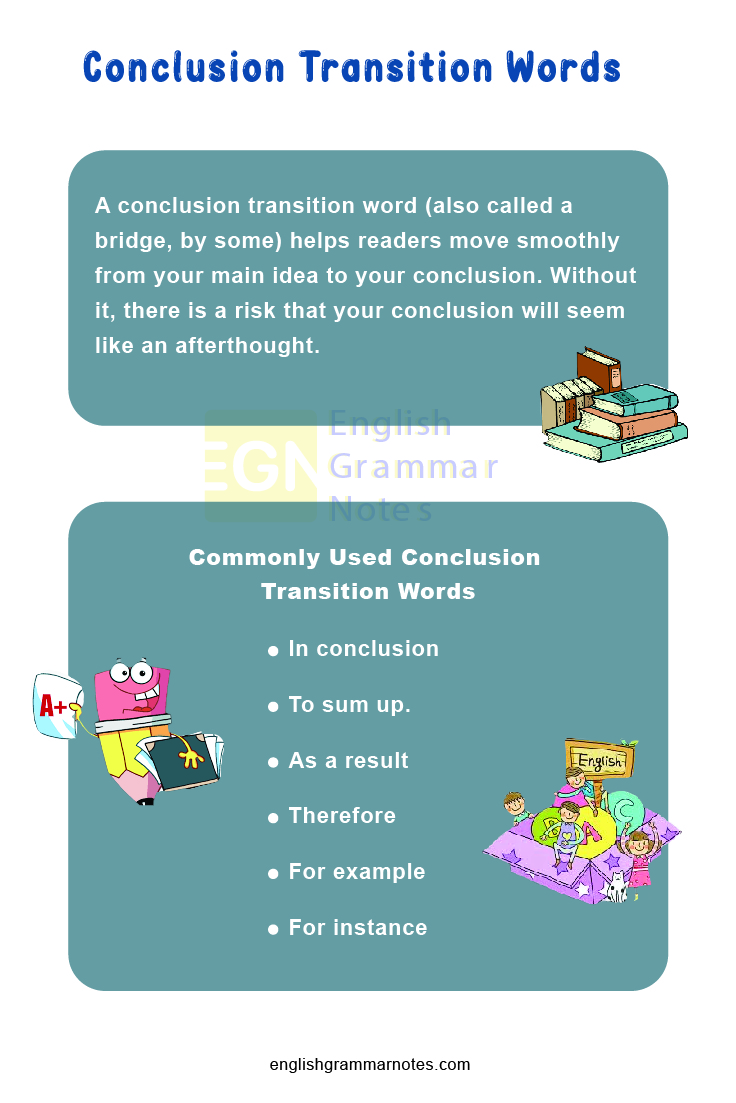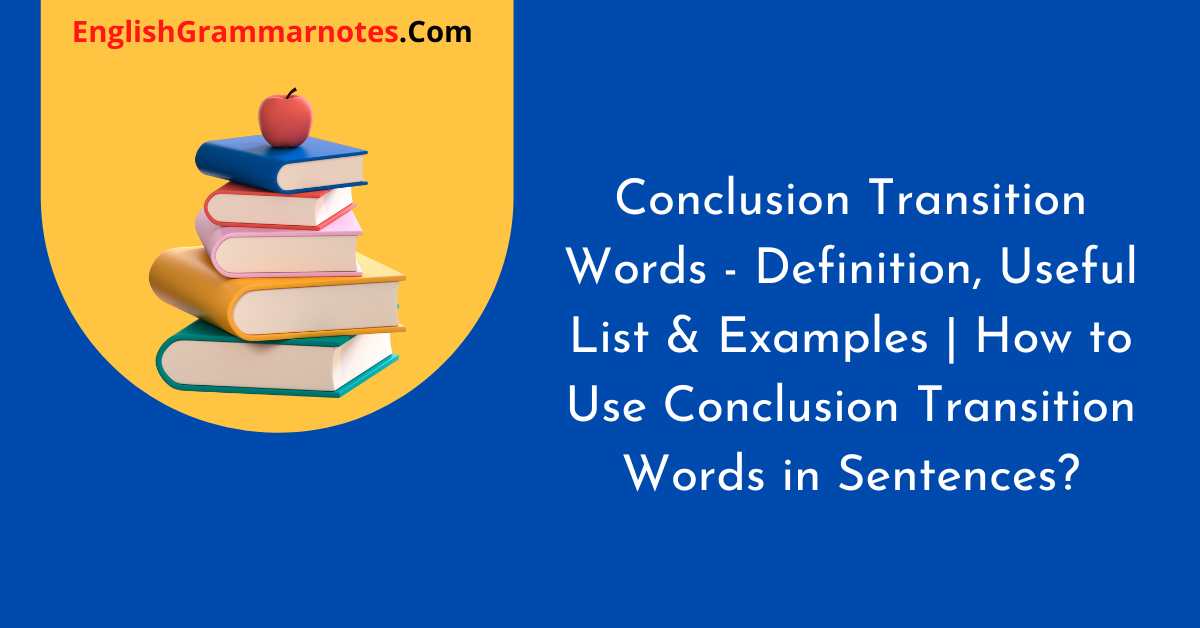The word conclusion refers to the ending of something and we want to end our writing in the most effective way possible. Luckily, many English teachers, editors, and authors agree that conclusion transition words are very important to use, but there’s one problem that all writers face when it comes to using them correctly: many don’t know what they are! In this guide, you’ll learn about the most common conclusion transition words and phrases so you can make your writing more effective than ever before.
- Types of Transition Words
- Conclusion Transition Words – Definition
- Commonly Used Conclusion Transition Words
- Examples on How to Use Conclusion Transition Words in A Sentence
- What is a concluding transition sentence?
- How do you start a conclusion paragraph?
- What is a good conclusion word?
- What are 5 examples of transitions?
Types of Transition Words
A transition word or phrase is a word or short phrase that connects two related parts of a sentence. It can be used to show change, contrast, comparison, addition, or other relationships between ideas.
There are several types of transition words and phrases that help the writer connect two sentences are as follows:-
- Compare/Contrast: They indicate a contrast between two ideas or actions. This can be done in one sentence, but it is often done in two separate sentences, with a comma to connect them. Contrast transition words may also come at the beginning of a sentence, rather than at its end.
- Chronology: These transition words are used to show a sequence of events in time, or to compare two or more actions that happened at different times.
- Cause/Effect: These transition words and phrases show a cause-and-effect relationship between two ideas or actions. They are often used to introduce an explanation of how something happened, why it happened, or what effect it had on something else.
- Illustration/Examples: These transition words and phrases show how one idea or action is like another, or how it might be considered to be an example of something else. They can also indicate that one idea is being used to explain another, or that it may be seen as an example of a broader concept.
- Addition: A transition word or phrase can also be used to show that one idea is being added to another, or that it may be considered an addition to a broader concept.
- Clarification: Sometimes a writer needs to use a transition word or phrase to clarify or explain something in an essay, story, report or another type of writing.
- Qualification: The transition words are used to qualify or restrict a previous statement.
- Summary/Conclusion: The transition words are used to connect a summary statement or conclusion with what has come before it in an essay, story, report, or another type of writing.
- Sequence: Sequencing transition words and phrases are used to show that one idea or action comes before another, after another, or at about the same time as another in a sequence of events.
Conclusion Transition Words – Definition
A conclusion transition word (also called a bridge, by some) helps readers move smoothly from your main idea to your conclusion. Without it, there is a risk that your conclusion will seem like an afterthought. A good transition accomplishes three things:
- It shows readers that you are wrapping up your discussion;
- It implies a connection between what you’ve just said and
- What you’re about to say; and sets up whatever you’re going to say next as obvious and inevitable.
There are many different conclusion transition words. Each can be used to subtly alter your argument or suggest a new line of thought. For example, you might decide to use nevertheless instead of but or consequently instead of and so. Whichever one you choose, always be sure that it fits logically with what you’ve already said before moving on to your conclusion.
The conclusion transition words that you choose should also reflect how confident you are in your main idea. This is an area where audience and purpose come into play. If you’re writing for a highly educated, specialized audience, it’s probably fine to use some big words and confident language to wrap up your argument—for example, henceforth or hence.
Commonly Used Conclusion Transition Words
Thus, In conclusion, To sum up, On concluding, As a result, It can be concluded that, The following are some of the most common conclusions transition words in English. This is not an exhaustive list. If you want to add more you can leave a comment and I’ll update it.
- In conclusion.
- To sum up.
- As a result.
- Thus.
- Therefore.
- Hence.
- Thus
- For example.
- For instance.
- So it can be concluded that.
- In short.
- In brief.
- To conclude.
- To summarize.
- At last.
- To finish up, I will conclude by saying that…
- In a nutshell, my argument is that…
- Let me conclude by saying that…
- Let me put it another way: …

Do Read:
Examples on How to Use Conclusion Transition Words in A Sentence
We can see that a transition word can also be used in a sentence to link two related sentences together. We see that our conclusion transition words in a sentence have connected with other parts of our sentence and led us smoothly from one place to another.
Example 1: In a sentence, transition words can be used to add meaning and help create smooth transitions between ideas. One way to do so is by using words like therefore or as a result. Let’s look at an example of how you can use these words in a sentence:
Here, we see that therefore connects two ideas to provide meaning.
Example 2: we can use transition words like first, second, and third to group related information in a sentence. Let’s look at an example of how you can use these words in a sentence:
Here, we see that first is used to connect two ideas and create a relationship between them. This word shows us that there is something before what comes next in our sentence.
Example 3: It’s also important to note that transition words aren’t only used in writing. For example, in a conversation you might say something like Hey, you know what? I read about… or I know, right? You see, it was really interesting how… In these cases, these are examples of how transition words can be used in a sentence to move conversations forward.
Example 4: Here, let’s look at an example of a conclusion transition word in a sentence In our final example, we see that finally is used to connect two ideas and give us some additional information about them. The sentence says: Finally, you will want to write down all your research on each piece of furniture and accessories so that you can keep track of everything you liked or didn’t like as well as anything else that stood out.
FAQs on Conclusion Transition Words
1. What is a concluding transition sentence?
A concluding transition sentence is a short phrase or clause that connects your thesis statement to your conclusion. It helps readers understand how you’re going to wrap up your argument.
2. How do you start a conclusion paragraph?
Begin your conclusion with a summarizing transition. Some examples include in the conclusion, to sum up, and overall.
3. What is a good conclusion word?
Concluding words are similar to transitional words, with one key difference. Transitional words help you move from one idea to another within a sentence while concluding words help you make a final connection between your thesis statement and your conclusion.
4. What are 5 examples of transitions?
Some examples of Transitions are:
- To sum up.
- Consequently.
- Thus.
- As a result.
- In conclusion.
Conclusion
We hope that you have enjoyed reading our latest e-guide and using these concluding transition words in your writing. To continue supporting you in your English learning, we would like to invite you to subscribe for free to our newsletter. With it, you will receive updates on our newest publications and some other surprises! You can sign up by entering your e-mail address below. Goodbye! Have a look at other articles as well How to Improve your Vocabulary.
